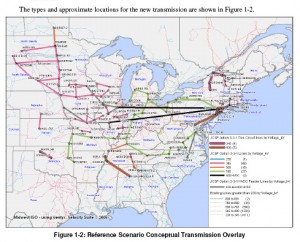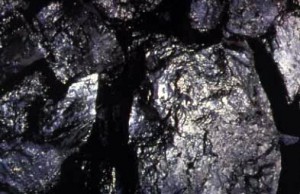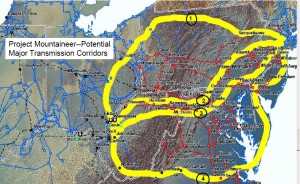
By standing up for offshore transmission for wind, Delaware’s Gov. Jack Markell stands up to Midwest coal!
The Mid-Atlantic states have been standing up and opposing transmission from the Midwest. They’ve gone on record in a number of venues, and in their opposition are citing Midwest transmission promoters’ disregard for eastern renewable efforts, that xmsn may well not be an economical way to get power to the east, and that THEY KNOW THAT MIDWEST TRANSMISSION PLANS INHERENTLY ARE ABOUT COAL. The plan they’re referring to is a massive transmission buildout known as JCSP, and it also applies to the big PJM buildout that includes the PA-NJ Susquehanna-Roseland transmission line that was the subject of a hearing last month.
Here’s JCSP (Joint Coordinated System Plan) note their site now talks about wind — but look where the transmission starts, DUH! The coal fields of the Dakotas:

Gotta give them, Delaware, Maryland and Virginia, a lot of credit for recognizing and stating what Midwest states have been unwilling to admit.

That said, here’s what Mid-Atlantic states are doing — they’re banding together to propose offshore transmission. If it’s underwater offshore transmission, that’s an idea that’s hard not to like. But I’ll bet it throws PJM for a loop, what with all their “backbone” transmission schemes, a la Project Mountaineer, that are in the works:

The FERC birth of Project Mountaineer:
Exhibit STL D-6a (PSEG Discovery Response)
Exhibit STL D-6B (PSEG Discovery Response)
And you can see that those lines in play now, PJM’s “backbone” transmission projects like Susquehanna-Roseland (NE part of Project Mountaineer Line 1) and MAPP (NE part of Project Mountaineer Line 4) are part of the plan… the big transmission plan that does not work for the east coast.
Here’s the Memorandum of Understanding between Delaware, Maryland and Virginia:
DE, MD & VA Wind Infrastructure MOU
And recently, Gov. Jack Markell addressed these issues before American Wind Energy Association’s offshore windfest — but given the PJM big-transmission-projects-from-hell are referred to as “backbone” projects, I wish they’d find another term:
By AARON NATHANS
The News Journal
BOSTON — If the Eastern Seaboard is to one day be dotted with thousands of wind turbines, they may as well work in harmony.
That’s the message 10 eastern governors are sending to the federal government as they advocate for a major underwater power line parallel to the East Coast.
U.S. offshore wind farm projects, all still on the drawing board, are being planned to include cables from the turbines to a substation on land to bring the power to the existing transmission grid.
The “backbone” power line the governors envision would connect the wind farms to each other, making it easier to spread wind power from areas where the wind is blowing robustly at that moment to states where electricity demand exceeds supply.
They see the backbone as preferable to a national investment in a transmission line that brings wind power from the Midwest to the East.
Gov. Jack Markell broached the subject this week in his address to the American Wind Energy Association’s offshore wind workshop, the industry event of the year on this side of the Atlantic. Markell signed onto letters the governors sent to members of Congress this summer, and the Federal Energy Regulatory Commission last month.
Governors of Vermont, New Hampshire, New York, Virginia, Maryland, New Jersey, Massachusetts, Rhode Island and Maine also signed the letters.
In an interview, Markell’s natural resources secretary, Collin O’Mara, said he wants to find out if there’s a way to spread out the costs of such a project. Building a backbone would help states satisfy their renewable electricity purchase requirements, and relieve the “spaghetti” structure of the current power grid, he said.
“Let’s have the conversation,” O’Mara said. “It’s extremely worthy of further study.”
Transmission is vitally important to getting offshore wind energy to population centers, said Denise Bode, the wind association’s president. And Gov. Donald Carcieri, R-R.I., called it “the elephant in the room.”
The power grid is “organized like a patchwork to meet local needs” rather than as a planned national system — almost an assemblage of local roads compared with an interstate, Carcieri said. The developers and government officials in attendance were very much aware of the role transmission will play in whether the offshore wind industry lives up to its potential.
The discussion comes as various offshore wind projects are maturing from concept to permitting, construction and design. At the moment, NRG-Bluewater Wind holds the only contract for offshore wind power, with Delmarva Power.
It’s starting the permitting process, getting ready to build weather towers off Delaware and New Jersey next summer, and preparing to bid for the right to develop an offshore wind project in New York City.
Jim Gordon, president of the Cape Wind venture that hopes to build in Nantucket Sound, told the convention he has all of the permits he needs from the state and federal government, but is working to overcome a tribal challenge that the waters in Nantucket Sound are protected.
The developer is working with the local utility — National Grid — to develop a contract to purchase power from the wind farm.
National Grid is also negotiating with Deepwater Wind for a contract to provide power to Rhode Island’s Block Island from a small, five-to-eight turbine facility in near-to-shore state waters. The company is also planning a larger wind farm in federal waters off the Rhode Island coast, which will take longer to build.
Deepwater, Bluewater and Fishermen’s Energy are planning wind farms off the New Jersey coast and the state government has provided incentives.
Deepwater CEO Bill Moore said, in principle, the backbone transmission line is “a terrific idea. It makes a lot of sense.”
But he said it’s a “daunting task” to complete an infrastructure project that crosses state boundaries, impacts different developers, and brings together different regional power grids.
“It obviously won’t happen in the absence of federal leadership,” he said.
Fishermen’s Energy President Daniel Cohen said it’s a good idea, but “it’s another moving part.”
“What comes first? Do you build the project or the backbone? People need to make decisions soon,” Cohen said, noting that the answer affects financing arrangements.
Gordon van Welie, president of ISO New England, the regional power grid manager, said there has been some investment in transmission upgrades, but a national plan is needed before new elements are selected.
“The rhinoceros in the room is the transmission cost allocation” — who benefits from a transmission line, and who pays for it, he said.
He noted that the New England governors adopted their own long-term vision of renewable energy, which included $6 billion in lines to transmit power from inland and offshore turbines to population centers.
The benefits of building lines transmitting wind power from the Midwest are less certain, he said.
“It will be difficult to get progress in this area until there are clear national goals,” he said.
Steven Bruckner, conservation chairman of the Virginia chapter of the Sierra Club, looked kindly upon the backbone idea. He said he didn’t have environmental concerns, although he wondered whether such a project would be economical.
“You’re talking hundreds, thousands of wind turbines off the coast, eventually displacing those coal burning power plants,” he said. “It’s the scale. It’s the beginning.”
Note that “cost allocation” is raised. Since the 7th Circuit decision tossing out FERC approval of PJM’s transmission cost allocation dream/nightmare, all transmission projects 500kV and over based on that cost allocation scheme are in limbo.
Illinois Commerce Commission v. FERC – August 6, 2009
So as noted, who pays, and submarine transmission is EXPENSIVE, is THE big issue now. It’s the big issue for land transmission, it’s the big issue for offshore transmission, and, given the uncertainty since the 7th Circuit decision, maybe some of the sturm and drang could be circumvented if it’s designed at 345kV or below, and uses the “benefactor pays” theory. We shall see…




Leave a Reply